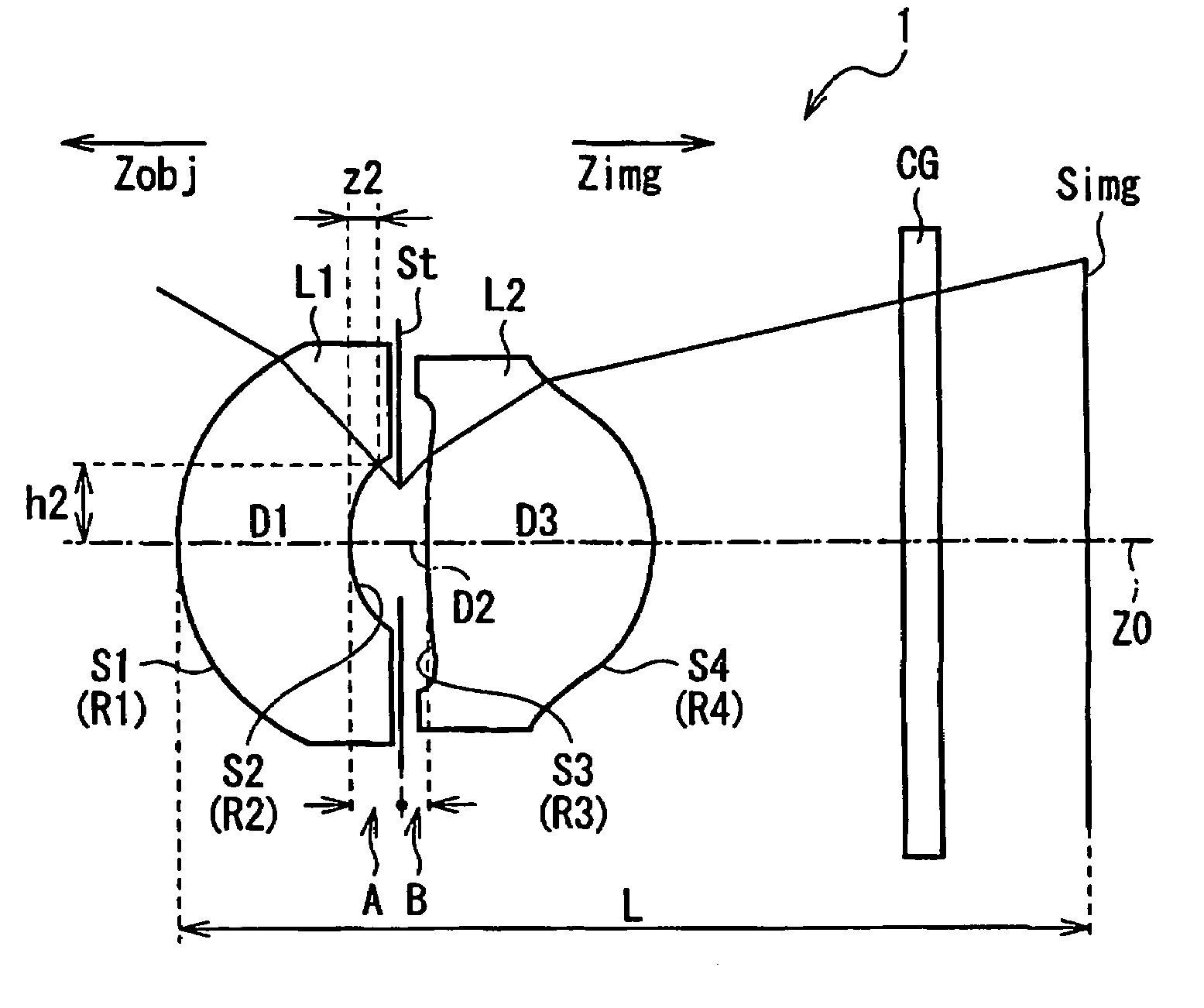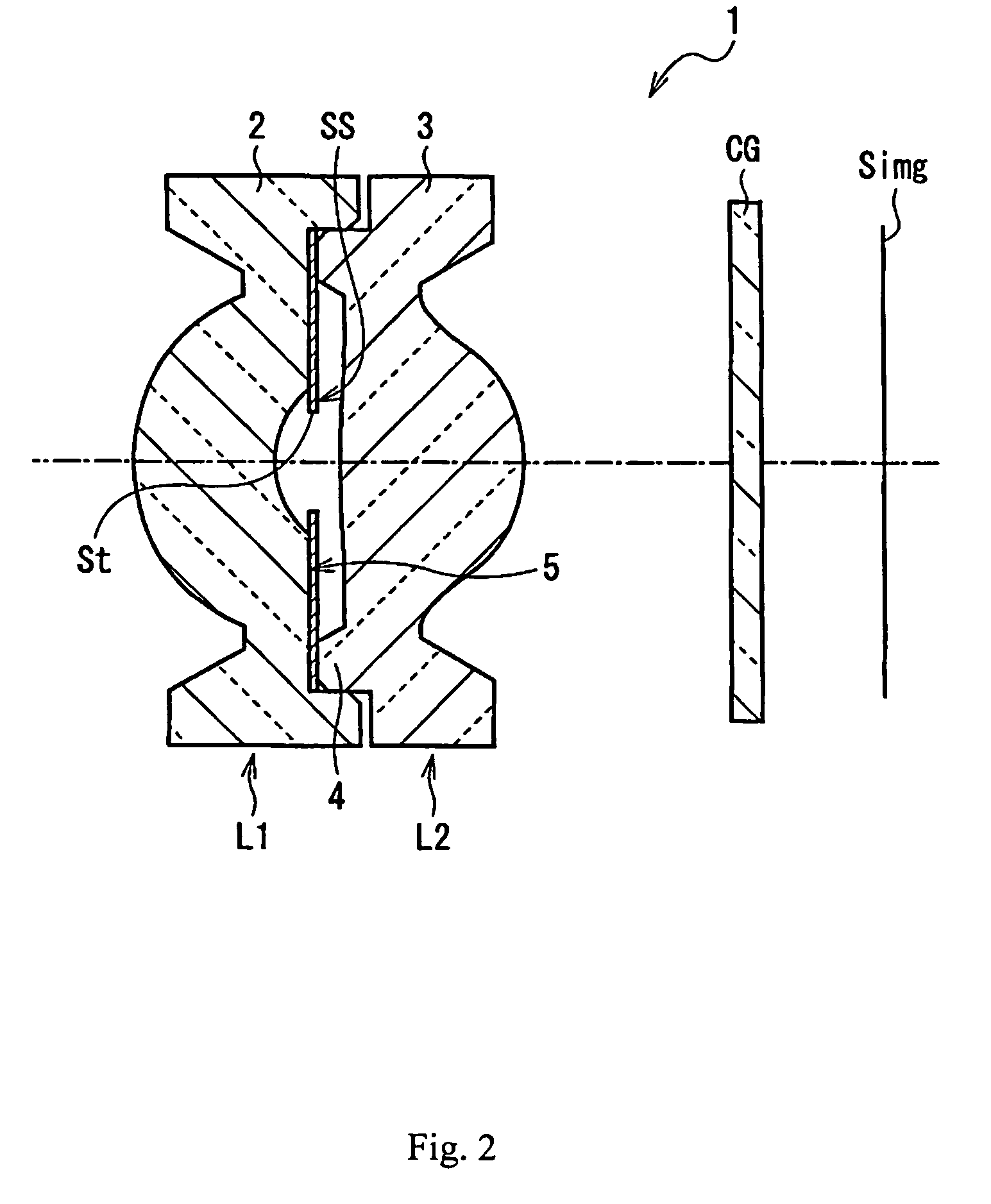Imaging lens
a technology of imaging lens and focusing lens, which is applied in the field of imaging lens, can solve the problems of not providing a sufficient field angle (i.e. field of view), and achieve the effect of bright image and large field angl
- Summary
- Abstract
- Description
- Claims
- Application Information
AI Technical Summary
Benefits of technology
Problems solved by technology
Method used
Image
Examples
embodiment 1
[0083]FIG. 1 shows Embodiment 1 of the present invention. Table 1 below lists the surface number #, in order from the object side, the radius of curvature R (in mm) of each surface near the optical axis, the on-axis surface spacing D (in mm), as well as the refractive index Ne (at the e-line of λ=546.1 nm) and the Abbe number νd (at the d-line of λ=587.6 nm) of each lens element for Embodiment 1. Listed in the bottom portion of Table 1 are the values of f, f1, f2, D, h2, and z2 (all in mm), which have been defined with respect to Conditions (1)–(3) and (6)–(8) above, for Embodiment 1. Also listed in the bottom of Table 1 are the distance L (in mm) along the optical axis Z0 from the first lens surface S1 of the first lens element L1 to the image plane Simg for an in-focus image of an object at infinity for Embodiment 1, the distances A and B (both in mm) defined above in relation to the position of the stop St and the vertices of lens surfaces S2 and S3, and the ratio B / A.
[0084]
TABLE...
embodiment 2
[0090]Embodiment 2 is very similar to Embodiment 1 and is well shown by FIG. 1. Table 3 below lists the surface number #, in order from the object side, the radius of curvature R (in mm) of each surface near the optical axis, the on-axis surface spacing D (in mm), as well as the refractive index Ne (at the e-line of λ=546.1 nm) and the Abbe number νd (at the d-line of λ=587.6 nm) of each lens element for Embodiment 2. Listed in the bottom portion of Table 3 are the values of f, f1, f2, D, h2, and z2 (all in mm), which have been defined with respect to Conditions (1)–(3) and (6)–(8) above, for Embodiment 2. Also listed in the bottom of Table 3 are the distance L (in mm) along the optical axis Z0 from the first lens surface S1 of the first lens element L1 to the image plane Simg for an in-focus image of an object at infinity for Embodiment 2, the distances A and B (both in mm) defined above in relation to the position of the stop St and the vertices of lens surfaces S2 and S3, and the...
embodiment 3
[0097]Embodiment 3 is very similar to Embodiment 1 and is well shown by FIG. 1. Table 5 2below lists the surface number #, in order from the object side, the radius of curvature R (in mm) of each surface near the optical axis, the on-axis surface spacing D (in mm), as well as the refractive index Ne (at the e-line of λ=546.1 nm) and the Abbe number νd (at the d-line of λ=587.6 nm) of each lens element for Embodiment 3. Listed in the bottom portion of Table 5 are the values of f1, f2, D, h2, and z2 (all in mm), which have been defined with respect to Conditions (1)–(3) and (6)–(8) above, for Embodiment 3. Also listed in the bottom of Table 5 are the distance L (in mm) along the optical axis Z0 from the first lens surface S1 of the first lens element L1 to the image plane Simg for an in-focus image of an object at infinity for Embodiment 3, the distances A and B (both in mm) defined above in relation to the position of the stop St and the vertices of lens surfaces S2 and S3, and the r...
PUM
 Login to View More
Login to View More Abstract
Description
Claims
Application Information
 Login to View More
Login to View More - R&D
- Intellectual Property
- Life Sciences
- Materials
- Tech Scout
- Unparalleled Data Quality
- Higher Quality Content
- 60% Fewer Hallucinations
Browse by: Latest US Patents, China's latest patents, Technical Efficacy Thesaurus, Application Domain, Technology Topic, Popular Technical Reports.
© 2025 PatSnap. All rights reserved.Legal|Privacy policy|Modern Slavery Act Transparency Statement|Sitemap|About US| Contact US: help@patsnap.com



